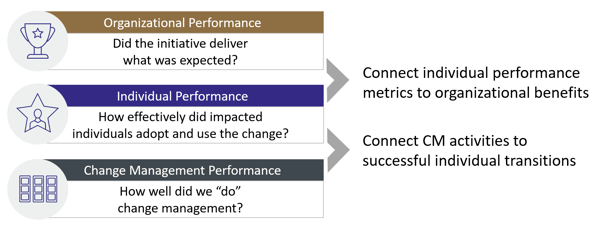Metrics for Measuring Change Management

4 Mins
Updated: September 2, 2025
Published: March 26, 2024

Change practitioners are increasingly expected to measure the contribution of their change management activities to achieving success on projects. If you aren’t doing so, you should start. Why? Prosci research shows a strong correlation between measuring compliance and overall performance with meeting and exceeding project objectives.
Prosci asked participants in the 12th Edition of Prosci’s Best Practices in Change Management research, "Did you measure compliance with the change and your overall performance in meeting project objectives?” and 63% agreed or strongly agreed with the statement. Of those who measured compliance of overall performance, 76% met or exceeded project objectives. In contrast, only 24% of the respondents who did not measure compliance and overall performance met or exceeded objectives.
What to Know Before Measuring Change Management Effectiveness
Having a common definition of success for your project or initiative is a critical prerequisite to measuring change management effectiveness. Defining success takes place at project initiation or earlier, and includes identifying the project’s objectives (what the project will achieve) and the organizational benefits (what the organization will gain).
"40% of respondents in our research identified the lack of alignment on goals and objectives as the main reason change success was not defined for their change projects."
As a first step, you should engage your key stakeholders—including your primary sponsor, senior leaders of the impacted groups, subject matter experts, and the project manager—in co-creating a shared definition of success for your project. This effort may require you to identify and facilitate any misalignment that exists among the key stakeholders.
According to our research, one of the major obstacles to defining change success at a detailed level is difficulty identifying appropriate KPI’s (reported by 29% of respondents). If you anticipate or are experiencing this obstacle on your project, you can:
- Encourage project sponsors and the project team to clearly define success criteria early on, whether for a traditional sequential project or an iterative project (e.g., sprints or releases)
- Advocate for a definition of success that extends beyond technical implementation to include measuring adoption and use of the change by impacted individuals and groups
- Introduce “people side” metrics early in the project when technical installation metrics are being defined
- Limit the number of change success metrics for the project to a few simple, trackable metrics
Once you agree on a definition of success for your project, the second step is to engage your key stakeholders in identifying the key performance indicators (KPIs) for measuring the effectiveness of your change management plans and activities.
The next step is to establish a regular cadence of monitoring progress. This means tracking the KPIs throughout the project lifecycle, analyzing the results, and identifying and taking adaptive actions.
"During the early stage of your change, be sure to present a case for the resources you will need to measure progress over time. You can do this by linking effective adoption and usage to project results and outcomes, including ROI. How much of the project’s expected ROI depends on adoption and usage?"
3 Levels of Performance Metrics for Change Management Projects
Measuring and monitoring effectiveness at three levels of performance—organizational performance, individual performance, and change management performance—enables you to create clarity and alignment on what your change aims to deliver. The three levels are interdependent and collectively provide a holistic framework for measuring overall performance.

1. Change management performance
How well did we do change management? This is the plain language question we need to answer to measure change management performance. When we do change management effectively, we prepare, equip and support people to be able to adopt and proficiently use a change in their work.
The metrics for this level of performance measure the completion, execution and effectiveness of the application of the Prosci Methodology. The change practitioner is primarily accountable for achieving the change management performance metrics.
The metrics are typically activity-oriented and could include:
- Completeness of the definition of change success
- Completeness of the change management strategy
- Tracking progress in executing the change management strategy
- Completeness of the master change management plan
- Tracking progress of activating the core roles (primary sponsor, sponsor coalition members, and people managers)
- Tracking progress to plan for executing change management plans and activities
- Completeness of the change management closeout
- Preparing and activating sustainment roles
- Tracking progress to plan for executing sustainment plan
- Execution of transferring knowledge and assets to the group responsible for sustaining the change
2. Individual performance
How effectively did impacted individuals adopt and use the change? This is the plain language question we answer when we measure individual performance. When we achieve a critical mass of people adopting and using the change proficiently, we begin to realize organizational benefits.
Measurement involves assessing individual and group progress in transitioning through the five elements of the ADKAR Model (Awareness, Desire, Knowledge, Ability and Reinforcement). Because the individual is the unit of change, measuring the progress of individual transitions is a leading indicator of the potential for adoption and use of a change.
When individuals and groups achieve Ability, we can start to measure outcomes, i.e., how effectively they are adopting and using the change in their work. We measure the outcomes by assessing three human factors:
- Speed of adoption of the change (how quickly)
- Ultimate utilization of the change (how many)
- Proficiency in applying the change (how well)
The specific metrics you select for each of these three human factors will depend on the type of change you are implementing and the industry. People managers are primarily accountable for ensuring the achievement of individual performance metrics.
Some examples of specific metrics or methods for measuring each of the three human factors include:
Speed of adoption
- Time required for employees to learn and apply new skills during and after training
- Number of people using the new system at go-live, 10 days after go-live, 30 days after go-live, etc.
- Tracking frequency of use, number of users, number of website visits, etc.
Ultimate utilization
- Measuring compliance with using a new business process through process audits
- Tracking use of a new system post-implementation by comparing the number of employees using the system to the total number of employees impacted by the change
- Estimating ultimate utilization by observing and monitoring employees working post-implementation
Proficiency
- Comparing work performance post-implementation against established KPIs
- Tracking the number of issues reported to support groups and help desks
- Conducting “show me” testing that requires employees to demonstrate their level of proficiency
3. Organizational performance
Did the initiative deliver what was expected? This is the plain language question we answer when we measure organizational performance. Success is defined as meeting or exceeding project objectives and realizing organizational benefits that are sustained over time.
The primary sponsor is accountable for clearly identifying the definition of success for the change and ensuring that the project objectives and organizational benefits are achieved. The change practitioner extracts and packages the definition of success by asking great questions of the key stakeholders and ensuring that the stakeholders are aligned with the definition of success.
The project manager is responsible for ensuring that the project objectives are defined and refined, as required, over the project lifecycle. They are also responsible for establishing and tracking KPIs that are specific to the type of change being implemented.
Change practitioners use the Prosci Change Triangle (PCT) Assessment to measure project health over the project lifecycle. Project health is a leading indicator of the potential for meeting or exceeding project objectives and realizing organizational benefits.
Change Management Metrics and Measurement
As the discipline of change management continues to evolve, the ability to clearly define success and measure results and outcomes on change projects are increasingly important skills for change practitioners to develop. You can learn more about how to measure the effectiveness of change management on a real project from your organization by attending the Prosci Change Management Certification Program.

.png?width=650&height=406&name=Data-Measure-CM%20(1).png)



